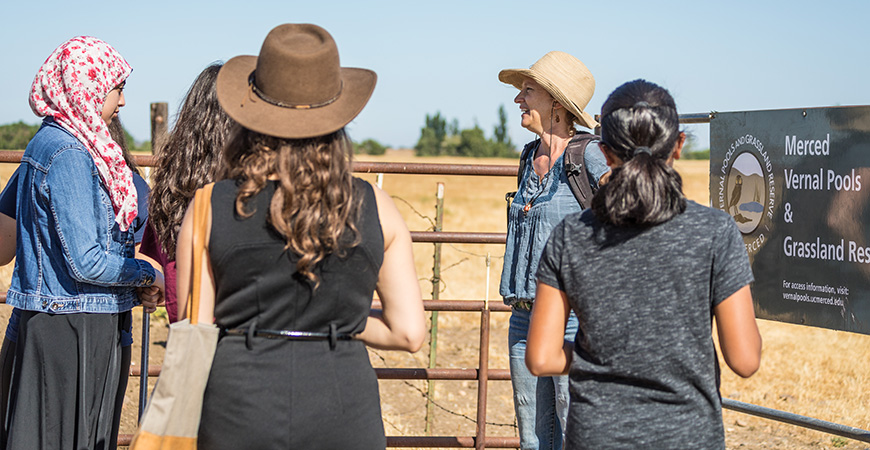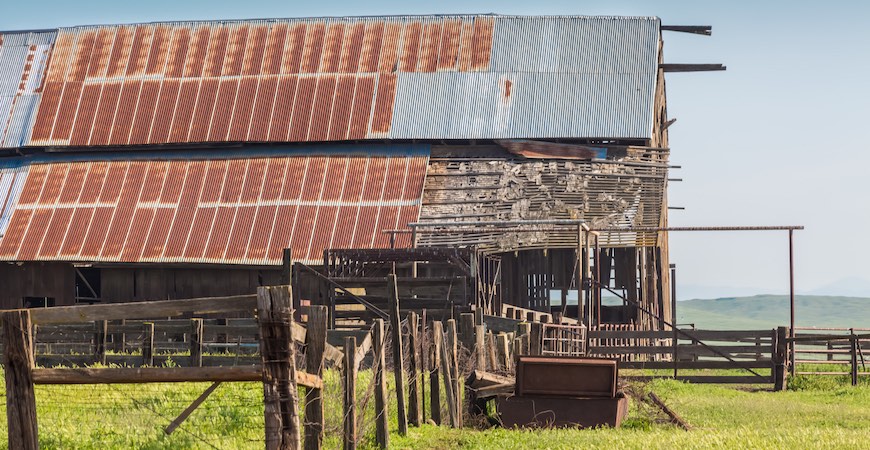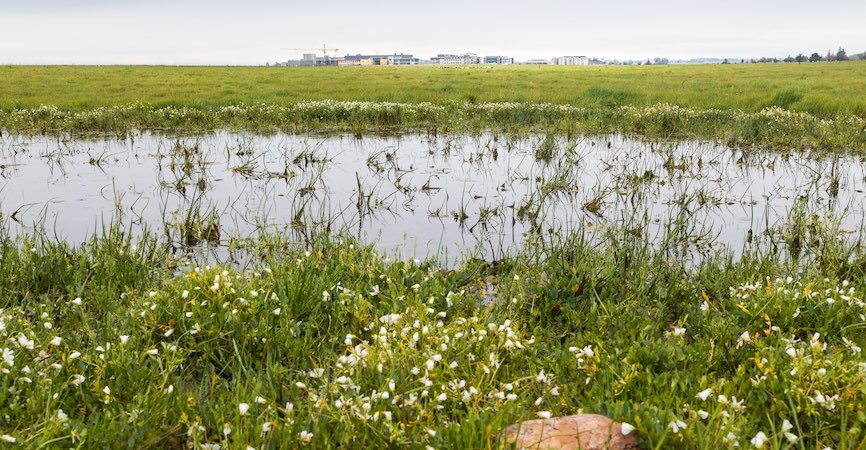
At the northern tip of the UC Merced campus, an unremarkable aluminum gate leads into a field that extends, seemingly, into infinity. Perpendicular to the gate, the LeGrand Canal, drawn from Lake Yosemite, snakes around campus into the emerald pastures, through farm rows and almond orchards across the highway. It’s the rainy season and bulbous cumuli foreground the rippled line of the Sierra Nevada that slices across the open sky.
This is no ordinary field or pasture. The UC Merced Vernal Pools and Grassland Reserve, or MVPGR, is the 39th of the 41 reserves in the University of California Natural Reserve System. NRS reserves serve as living laboratories and outdoor classrooms for students and researchers at UC and beyond.
An immensely biodiverse habitat, the MVPGR is home to 415 plant species (more than 25 of which are rare and protected plants), endemic and endangered fairy shrimp, 83 bird species, four species of amphibians (including the California tiger salamander, federally designated as vulnerable), four kinds of reptiles and 13 species of mammals. Protected by conservation easements, the 6,428-acre reserve is part of the largest vernal pool grassland ecosystem left in California.
Soon, Reserve Director Monique “Mo” Kolster arrives on a small utility vehicle to conduct a tour. Her Gator navigates the bumpy path while a herd of Friesian heifers on adjacent ranchland tries to keep pace.
Suddenly, Mo skids the Gator to a stop. She grabs a pair of smudged field glasses from the seat, and turns toward a rustle in the grass not far from the road.
Through the glasses, Mo spots a burrowing owl. Its head pokes up to look around, then disappears again into a den beneath our sightline. An American kestrel zips across the sky. Another bird circles overhead, taking its time to survey the landscape for prey – either a Northern Harrier hawk or a Swainson’s hawk; both thrive on the MVPGR.
Driving deeper into the grasslands, a series of rickety gates usher the cows from one parcel to another. The herds are rotated as part of the adaptive grazing management plan, and help control the nonnative species. Out here, the temperature cools, and the air seems to give off more oxygen. Weeds and wildflowers are just emerging – white tipped clover, coyote thistle, pineapple weed, frying pan poppy, butter-and-egg and waves of white meadowfoam. With each successive gate along the trail, new and different species emerge –painted lady butterflies, western meadowlarks, a black-tailed hare, and a scurry of California ground squirrels.
“It's an absolute joy to bring people out to the reserve and introduce them to the wonders of the extreme and fascinating vernal pool habitat,” said Kolster.
“Often people don't realize that the Central Valley contains these biodiversity gems, and when they learn about the life history of fairy shrimp, California tiger salamanders and amphibious wildflowers – their importance regionally and on a larger scale – they can't help but feel in awe of nature.”

The Virginia Smith Trust barn
Before reaching the vernal pools, Mo slows the Gator by the remains of the Virginia Smith Trust barn. Constructed in 1923, the barn gave way to the wind in April. Its mossy, aged redwood frame has collapsed into a heap of ruin.
The barn evoked a sense of place, tradition, and belonging for the Merced community. Farmers have long raised barns even before building their houses. These bucolic structures now serve as links to the past, nostalgic symbols embodying a closeness to the land.
A two-story wooden ranch house and several outbuildings also stood with the barn until the 1960s. Their foundations still demarcate the northwest corner of the property in ghostly homage to past generations. Opposite the barn, a creaky windmill continues to fill three dented cylindrical tanks, supplying water vital to the nearly 1,600 dairy cows pastured here as an essential part of the intricate ecosystem.
These lands were once part of the territory of the Yokut people. Prior to European contact, the Yokuts consisted of up to 60 tribes, many of whom spoke different languages. The Yokuts populated the San Joaquin Valley from the Sacramento-San Joaquin River Delta south to Bakersfield and east to the adjacent foothills of the Sierra Nevada.
The barn is irreplaceable, but the commitment to UC Merced’s mission of ‘building the future’ includes a new field station to facilitate and support diverse activities for research, education and public service. The new field station will serve as a gathering place for the people of the Central Valley to preserve their rich history and heritage through environmental stewardship and conservation.
“Our hope is that a field station would really unite all the different threads of the reserve,” said Professor Jessica Blois, faculty director of the Merced Natural Reserve. “It would serve as a nexus for researchers, for students of all ages, and for the broader community to come together and continue to support the MVPGR.”
More than the sum of its parts
“The MVGPR is such an important resource for our community,” said Blois. “We have a huge natural, preserved area adjacent to campus that allows our faculty to do world-class research – on really diverse and important topics – and also serves as a “living laboratory” for our students. It’s one the best features of UC Merced.”
Part of what makes the Reserve’s ecosystem so exceptional is its combination of human-made and naturally occurring features. These elements work together as one holistic ecosystem.
The hallmark of the reserve is its vernal pools. These seasonal, ephemeral wetlands fill with rainwater during the cool, rainy winters and springs of California’s Mediterranean climate. Soon after the rainclouds depart, the pools may go dry for most of the summer and fall.
On the surface, the vernal pools appear to be little more than concave shallow depressions within the gently sloping planes of the grasslands. They’re frequently tucked between the mima mounds — low, flattened domes of soil that give these grasslands a bumpy surface. Beneath the surface, however, the pools teem with endangered fairy shrimp that drop their eggs in the soil that lies above the impermeable clay which lines the pool. Able to withstand extreme heat, cold and desiccation, fairy shrimp eggs are also known as cysts.
Only 5-10 percent of vernal pools are still in existence today. The reserve may have the densest concentration of vernal pools remaining in the West.
Reserve grasses, however, are primarily nonnative. They were brought to California with livestock by Spanish ranchers and then Gold Rush miners and settlers. By eating the non-native European grasses, the cows help prevent these invasive plants from becoming established in vernal pools and degrading the vernal pool ecosystem.

Research
The MVPGR is used by students, UC Merced faculty members and other researchers to study natural systems, communities and ecological processes.
For example, UC Merced Professor YangQuan Chen is using the reserve to test how well small Unmanned Aerial Systems technologies can detect methane pipeline gas leaks around structures. The project is a partnership with NASA’s Jet Propulsion Laboratory and PG&E. In another project, UC Merced Professor Jay Sexton is applying conservation genomics to a tribe of vernal pool grasses to better understand range-wide levels of genetic variation, as well as to identify potential sources and sinks of genetic variation in these fragmented remnant ecosystems. Sexton is also testing how well DNA barcoding can characterize soil seed banks and the environmental DNA – eDNA – of plants and animals in vernal pools.
Teaching
The proximity of the reserve to campus enables professors to take students into the field for hands-on, experiential learning for courses ranging from conceptual art to natural sciences to engineering.
Two to three times each year, local high school students take part in soil sampling research the MVPGR for the CALeDNA program. CALeDNA pairs volunteer community scientists with University of California researchers to collect soil samples from across California. The DNA in the samples are then analyzed to identify any species that may have passed by.
For many of these K-12 students, the MVPGR offers their first exposure to a university campus. They learn how to conduct a scientific experiment, make and record their observations, and learn about different flora and fauna using guidebooks and information. Many undergraduate students at UC Merced also undergo training in reserve biology and to present that information to reserve visitors as MVPGR student rangers. Students are encouraged to consider actions they can take now, and in the future, to protect the environment.
Public Service
Aligned with the University of California’s mission to engage in public service, the MVPGR holds outreach events and programs to involve the public in cutting edge research. Student interns and reserve staff host 8-mile hikes twice a year. During peak wildflowers season, the public is invited to guided nature walks, and prospective UC Merced students tour the MVPGR with their families to gain a sense of university initiatives to promote sustainability. Groups such as the Audubon Society, the Merced Camera Club, and the California Native Plant Society also enjoy the MVPGR.
The Future
Visitors undergo a transformation while journeying along the reserve’s winding paths. Witnessing firsthand the workings of a vibrant ecosystem sparks both intellectual discovery and awareness of the moral responsibility to preserve and protect our natural lands.
Perhaps this is what Ken Norris, a UC professor and renowned naturalist, envisioned when he founded the University of California’s Natural Reserve system in 1965. Norris recognized the need to protect natural places where long-term research and experiential outdoor education can occur amidst California’s burgeoning population and growing cities.
Since the 18th century, the tradition of barn raising remains largely unchanged. It’s a communal effort demanding more labor than a single family can provide. Raising a new field station for the MVPGR is no different. This undertaking will demand the efforts of a whole community -- including neighbors and friends – and yield a great benefit for future generations.
Lorena Anderson

Senior Writer and Public Information Representative
Office: (209) 228-4406
Mobile: (209) 201-6255






